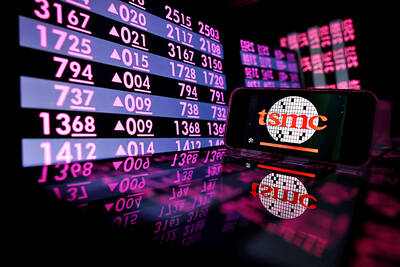Mizuho Financial Group, one of Japan's Big Four banks, yesterday sharply lifted its earnings forecast for the first fiscal half ending Sept. 30, citing a decline in bad loan write-off costs.
Mizuho, the world's biggest bank in terms of assets, expects a ?230 billion (US$2.1 billion) profit for the six-month period, up from ?100 billion (US$901 million) projected earlier.
Mizuho Financial Group kept the outlook for group operating revenue the same from the earlier projection in May of ?1.6 trillion (US$14 billion). Mizuho said it will release its earnings forecast for the full fiscal year through March when it announces interim results in November.
Mizuho shares have more than tripled since March on signs that Japan's economic recovery is gathering momentum, making it easier for borrowers to repay loans. Prime Minister Junichiro Koizumi last month reiterated his resolve to clean up US$384 billion of bad loans remaining at Mizuho and other lenders.
"Japanese bank stocks have become a leveraged play on the market and to an extent on the economy as a whole," said Jonathan Allum, Japan strategist at KBC Financial Products UK Ltd. in London. "The wind is blowing in the right direction. When it's good it's very good, when it bad it's horrid."
`This revision offers further confirmation for investors that Japan's banks are likely to return to profit in their current business year after two years of losses," said Nedeltcho Akov, a banking analyst at ING Securities Japan Ltd. in Tokyo.
Mizuho and other Japanese banks have pledged to turn into the black this year after posting massive losses over the past two or three years. The nation's recent economic recovery and the rise on the Tokyo stock exchange have helped the performance of Japan's banks, which have been struggling with loans gone sour.
Japan's economy has gradually recovered from a long slowdown in recent months.

Taiwan Semiconductor Manufacturing Co (TSMC, 台積電) yesterday said that its investment plan in Arizona is going according to schedule, following a local media report claiming that the company is planning to break ground on its third wafer fab in the US in June. In a statement, TSMC said it does not comment on market speculation, but that its investments in Arizona are proceeding well. TSMC is investing more than US$65 billion in Arizona to build three advanced wafer fabs. The first one has started production using the 4-nanometer (nm) process, while the second one would start mass production using the

A TAIWAN DEAL: TSMC is in early talks to fully operate Intel’s US semiconductor factories in a deal first raised by Trump officials, but Intel’s interest is uncertain Broadcom Inc has had informal talks with its advisers about making a bid for Intel Corp’s chip-design and marketing business, the Wall Street Journal reported, citing people familiar with the matter. Nothing has been submitted to Intel and Broadcom could decide not to pursue a deal, according to the Journal. Bloomberg News earlier reported that Taiwan Semiconductor Manufacturing Co (TSMC, 台積電) is in early talks for a controlling stake in Intel’s factories at the request of officials at US President Donald Trump’s administration, as the president looks to boost US manufacturing and maintain the country’s leadership in critical technologies. Trump officials raised the

‘SILVER LINING’: Although the news caused TSMC to fall on the local market, an analyst said that as tariffs are not set to go into effect until April, there is still time for negotiations US President Donald Trump on Tuesday said that he would likely impose tariffs on semiconductor, automobile and pharmaceutical imports of about 25 percent, with an announcement coming as soon as April 2 in a move that would represent a dramatic widening of the US leader’s trade war. “I probably will tell you that on April 2, but it’ll be in the neighborhood of 25 percent,” Trump told reporters at his Mar-a-Lago club when asked about his plan for auto tariffs. Asked about similar levies on pharmaceutical drugs and semiconductors, the president said that “it’ll be 25 percent and higher, and it’ll

CHIP BOOM: Revenue for the semiconductor industry is set to reach US$1 trillion by 2032, opening up opportunities for the chip pacakging and testing company, it said ASE Technology Holding Co (日月光投控), the world’s largest provider of outsourced semiconductor assembly and test (OSAT) services, yesterday launched a new advanced manufacturing facility in Penang, Malaysia, aiming to meet growing demand for emerging technologies such as generative artificial intelligence (AI) applications. The US$300 million facility is a critical step in expanding ASE’s global footprint, offering an alternative for customers from the US, Europe, Japan, South Korea and China to assemble and test chips outside of Taiwan amid efforts to diversify supply chains. The plant, the company’s fifth in Malaysia, is part of a strategic expansion plan that would more than triple